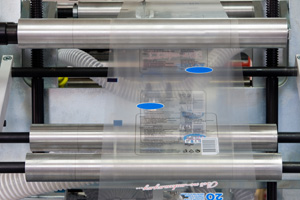

The process of monitoring and adjusting the tension applied to material being wound onto a spool, reel or drum is known as web tensioning. In industries where materials such as paper, plastic film, aluminum, fiber or wire must be wound on to a reel, web tensioning is a key portion of the manufacturing process that contributes to uniformity, quality and productivity. Rotary encoders are often applied in conjunction with other feedback devices and sensors to control web tension.
A typical web tensioning application involves one encoder mounted on a drive motor and a second encoder mounted to a tensioning roller arm or pinch roller. Both encoders supply a speed data to the controller. If variations in the rotation speed of the motor and roller occur, the controller adjusts the drive motor in order to maintain a constant level of tension on the material.
Mechanically, shaft, thru-bore or measuring wheel encoders can be applied, depending what design is most readily integrated into the system. Integrated encoder-measuring wheel solutions such as EPC's Model TR1 or TR3 TruTracTM are well suited for web tensioning applications.
Electrically, variables such as resolution, output type, channels, voltage, etc, all should be specified to meet the individual application requirements. In the vast majority of installations, incremental encoders are most suitable, with quadrature output being useful in order to avoid edge jitter during stoppage. Special attention should be given to the potential for static discharge, grounding and isolation of the encoder.
Environmentally, proximity of the encoder to potential exposure to liquids, fine particulates and extreme temperatures will dictate specification. In applications with wash down requirements, an IP66 or IP67 seal can offer protection against moisture ingress. However, consider a stainless steel or polymer composite housing to mitigate the effects of harsh cleaning chemicals and solvents.
Examples: